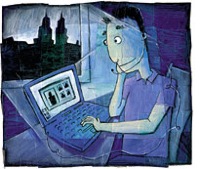Teleconference
A teleconference or teleseminar is the live exchange and mass articulation of information among several persons and machines remote from one another but linked by a telecommunications system. Terms as audio conferencing, telephone conferencing and phone conferencing are also sometimes used to refer to teleconferencing. The telecommunications system may support the teleconference by providing one or more of the following audio, video, and/or data services by one or more means, such as telephone, computer, telegraph, teletype, radio, and television.[1]
Teleconferencing is small group communication through an electronic medium. Teleconferencing is an electronic meeting which allows 3 or more people to meet across times zones or office cubicles. Teleconferencing is used as a short hand term to represent an array of technologies and services like a three way telephone conversation and a full motion color television. Conference calls connect people through a conference bridge, which is essentially a server that acts like a telephone and can answer multiple calls simultaneously.
Audio Conferencing • It historically began with the familiar “conference call,” generally set up by an operator working with the local telephone company • relies primarily on the spoken word, with occasional extra capacity for faxing documents or “slow scan” image transmissions • Over 20 billion minutes of use per year and an annual unit volume growth rate of over 20%, audio conferencing remains the most commonly-used form of teleconferencing today • Limited calls between two sites only require a set with either a three way calling feature or a conferencing feature supported by a PBX (private branch exchange) • Adding additional sites to an audio conference requires an electronic device called a bridge to provide the connection
Video Conferencing • It offers glamour but has not fully caught on as a routine business tool because of its technical complexity • The most common method used to connect individuals for a video conference is through a computer network • The computer network is the central hub where all the participants go to connect to the conference • There are 2 main ways to connect the participants to the central hub which are the ISDN networks or the IP networks Computer Mediated • Rather than video conferencing which is a ‘see me’ type of interaction, computer mediated conferencing is more about ‘see what I see’ • At the most basic form computer mediated is the written form of a conference call
Internet teleconferencing
Internet teleconferencing includes internet telephone conferencing, videoconferencing, and Augmented Reality conferencing.
Internet telephony involves conducting a teleconference over the Internet or a Wide Area Network. One key technology in this area is Voice over Internet Protocol (VOIP). Popular software for personal use includes Skype, Google Talk, Windows Live Messenger and Yahoo Messenger.
A working example of a Augmented Reality conferencing was demonstrated at the Salone di Mobile in Milano by AR+RFID Lab. [2] TELEPORT is another AR teleconferencing tool.[3]
References
- This article incorporates public domain material from the General Services Administration document "Federal Standard 1037C" (in support of MIL-STD-188).
- AR conferencing show in Milano
- AR Teleconferencing
August E. Grant and Jennifer H. Meadows. Johansen, et al. PowerHouse-Promotions Perera, R. (2001, October). "Teleconferencing demand up since September 11." Computerworld Hong Kong. Lynn Marotta. "How does video conferencing work? A look at some of the basics of setting up a video conference."
